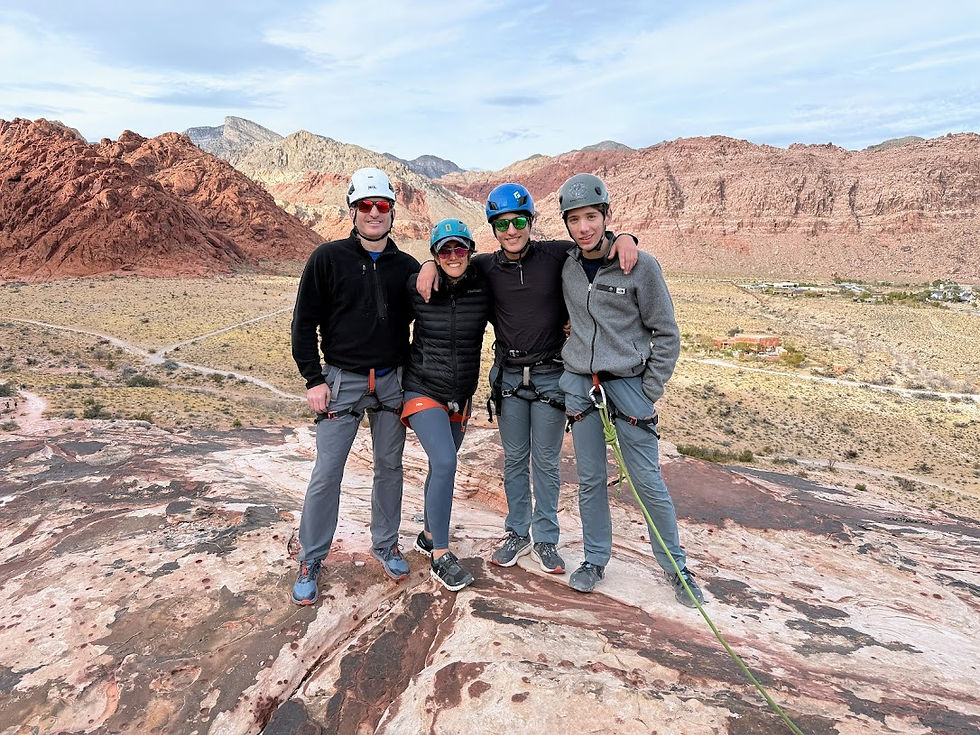Exploring the Evolution of Route Development in Red Rock Canyon From Pioneers to Modern Climbers
- Mike Donaldson
- Aug 6
- 4 min read
Updated: Aug 7
Nestled just outside Las Vegas, Nevada, Red Rock Canyon is celebrated not only for its breathtaking desert landscapes but also for its deep climbing roots. It attracts rock climbers from around the world, offering a unique blend of adventure and challenge. This blog post uncovers the extensive history of route development in Red Rock Canyon, highlighting early pioneers, ongoing ethical discussions, and the current landscape for new routes.
Early Pioneers and New Route History
The journey of climbing in Red Rock Canyon dates back to the late 1960s and 1970s, a time when brave climbers first explored the rugged cliffs. Noteworthy climbers such as Jim Bridwell and Joe Herbst were among the first to chart these territories. They used a ground-up approach where minimal bolting was employed, showcasing their skills and the beauty of the natural rock.
For instance, the first route established by Jim Bridwell, "The 6th Dimension," exemplified this principle, offering climbers a pure ascent that required placing protection as they climbed. Such approaches nurtured a culture of skill and respect for nature, emphasizing the thrill of climbing as a means of connection to the environment.
As climbing gained popularity through the late 70s and early 80s, more climbers like Tom Moulin joined in, spearheading additional route development. Their contributions expanded the canyon's reputation, providing climbers with a wide array of options ranging from easy to hard routes. By the 1980s alone, Red Rock Canyon boasted over 200 established climbs, attracting a growing community of climbers.
The gradual increase in climbers not only helped preserve the area's rich climbing history but also fostered a collaborative spirit in developing new routes.
Ethics Debates: Ground-Up vs. Rap Bolting
As climbing traffic surged, ethical debates emerged around routes’ development styles—specifically between ground-up climbing and rap bolting. Each method illustrates differing philosophies shaping the climbing experience.
Ground-up climbing is rooted in respecting the natural environment. Climbers work their way up, placing protection as they ascend. This approach keeps the climbing experience authentic and challenging, aligning with the founding principles of climbing in Red Rock. For example, many climbers cherish routes like "The Predator," which encapsulate the adventurous spirit of this style.
On the opposite end, rap bolting is where climbers descend to install bolts, often improving accessibility but raising concerns of environmental alteration. Critics argue that this method can lead to over-bolting and diminishes the challenge and beauty of the natural terrain. However, proponents point out that rap bolting opens doors for inexperienced climbers, enabling them to enjoy the sport.
This ongoing discussion highlights a crucial balance within the climbing community: preserving historical ethics while allowing growth in new climbing routes. Many climbers in Red Rock Canyon actively seek this equilibrium, navigating the complexities of preservation, accessibility, and ethical climbing practices.
Current Status of New Route Development
Today, route development in Red Rock Canyon remains active and vibrant, enticing climbers from all parts of the globe. With unique sandstone formations and stunning landscapes, climbers continue to explore untouched areas, driven by the dual goals of challenge and environmental respect.
Modern developers are utilizing techniques from both ground-up and rap bolting styles to enhance the variety and quality of climbing routes. This blend showcases the evolution of climbing as many developers focus on creating sustainable routes that offer diverse challenges while honoring the environment.
Recent advancements in climbing gear have significantly impacted route development. Improved safety equipment has made exploring previously uncharted rock faces much safer, enabling climbers to take on more ambitious challenges. Presently, there are over 1,700 routes in Red Rock Canyon, highlighting the area's continued allure and potential for new climbers eager to test their skills.
Notable Developers: Joe Herbst, Tom Moulin, and Handren
The legacy of Red Rock Canyon’s route development owes much to several key figures. Joe Herbst, an early pioneer, is known for an impressive range of first ascents and informative guidebooks that have shaped climbing culture in the area. His guidebooks have introduced climbers to many iconic routes while establishing standards for route creation.
Tom Moulin later expanded the boundaries of climbing difficulty with routes that offered various challenges. Climbers flocked to his climbs due to the technical intricacies involved. For example, Moulin's "The Rapture" route became a benchmark for challenging climbing, attracting experienced climbers seeking to push their limits.
In recent years, Handren has emerged as a significant contributor to the current climbing landscape. With a strong focus on sustainable practices and promoting climber cooperation, he is part of the next generation that emphasizes mindfulness in route development. His efforts underscore the importance of protecting the climbing environment while fostering innovation and collaboration among climbers.
These developers continue to inspire the climbing community, embodying the principles of respect for nature and passion for climbing that define Red Rock Canyon today.
Looking Ahead
The journey of route development in Red Rock Canyon encapsulates the evolution of climbing culture itself. From the inspiring early days of pioneers to today’s discussions around ethics, the narrative is woven with adventure, transformation, and a commitment to preservation. As fresh generations of climbers explore this magnificent region, the insights gained from early pioneers and ongoing ethical debates will crucially inform the future of climbing here.
Red Rock Canyon remains a sanctuary for adventurers, where every crag is a story waiting to be told. Whether you are a seasoned climber or a newcomer looking for an exhilarating experience, the climbing routes in Red Rock Canyon welcome you, inviting everyone to take part in its rich history.



.png)


Comments